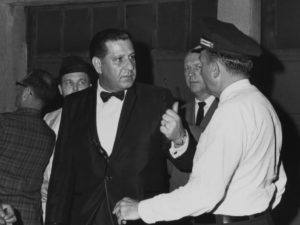Last week I attended a rally to call for the city to tear down the statue of Philly’s former white supremacist police chief and mayor, Frank Rizzo.
The statue is a worthy target. Rizzo was an avowed and violent white supremacist, a police chief who attended a party wearing a tuxedo with a billy club tucked in his cummerbund. Rizzo once publicly said that when he finished with his opposition, he would “make Attila the Hun look like a faggot.”

Though we were there to remove the statue, the protest was really against all the injustices waged on Black, Brown, and poor people. Many rightfully declared that removing a statue shouldn’t allow fairweather activists to pat themselves on the back about the supposed progress made. The symbolic removal of the statue must be tied to actual improvements in people’s lives—including within our schools.
In fact, public schools came up a lot in the speeches at the protest—including the deliberate underfunding of Black schools, the suppressed wages of educators teaching Black, Brown, and poor students, and the decaying physical conditions of our schools.
“Get Their Black Asses”
At the rally, I ran into three former students. And I remembered that their understanding of justice hinges on their understanding of historical precedent.
They knew about Black Friday on November 17, 1967.
School district officials recalled watching cops beat Black children for having a rally protesting the lack of Black teachers and Black studies. “A cop chased two black girls right outside of the window of the administration building where we were looking out,” the school district’s then-public relations manager remembered years later, “and just proceeded to beat the crap out of them with a nightstick.”
My elementary school (which I’ve written about before) commemorated this incident yearly.
When Rizzo sicced his cops on Black high school students, he told them, “Get their Black asses.”
Confederate statues may be in the south, but the confederate mindset was and is prevalent across America.
What does this have to do with educational justice? Everything!
Students should be engaged in an education that supports them in connecting the dots between present day circumstances and context and their historic precedents and predecessors. Students should see examples of empowerment as they practice using their voices and building platforms and blueprints to address the myriad forms of inequity that they face.
Our students are brilliant and resilient. “Teach them well and let them lead the way.” (George Benson’s version of the song).


The reflections that you shared in your last blog rekindled feelings from seeing Rizzo during my early years, treating Black, Brown and even poor whites as third class citizens. His speeches and continued rhetoric was both disturbing and even close to statements used by Hitler and other dictators in other countries.
I was fearful of the actions of the police and other city officials as I traveled around Philly in my day to
day life always looking at the police with caution and fear, unfortunately the Black officers too, because I did not know where their alliances were.
Thanks for sharing, this outlines the need for parents and community stakeholders to use
every opportunity to engage their children in learning and continued educational growth.
Teaching in Florida for over 25 years I still see disparities in educational access,
teachers of color and culture and the need offer vocational educational opportunities.
Keep up the good works.
Wm Jackson